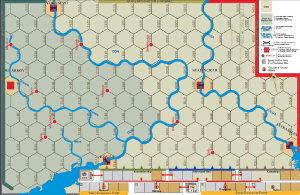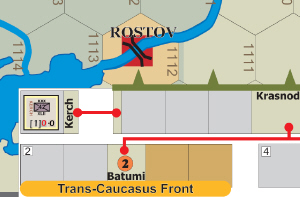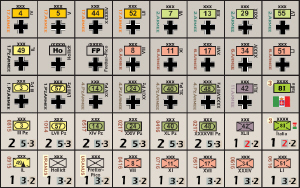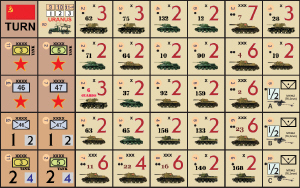|
|
||||||||
DECISIVE STALINGRAD A PREVIEW OF STALINGRAD: PIVOT ON THE VOLGA FOR TURNING POINT SIMULATIONS
Important Note: Since the publication of this article, the game's name has been changed to The Battle of Stalingrad, and the artwork has been upgraded so that town names are now in the center of hexes instead of at the vertices. At present, there are four boardgames planned for release in Turning Point Simulations' first year. These cover the battles of Tours in 732, pitting the Franks against the invading Muslims, Joan of Arc's victorious campaign of 1429 and 1430, Russia's defeat of Sweden in the Great Northern War, and the Stalingrad campaign. At this date the Tours game, designed by Richard Berg and titled The Hammer, is finished in its development, and the next stage is art. The Poltava game is ready for development. Andy Nunez's strategic Orleans game, Render to the Maid, and Hjalmer Gerber's Stalingrad: Pivot on the Volga are being developed now. Stalingrad: Pivot on the Volga deserves attention for a couple of reasons. One is that it is one of the best-looking, most extensively-tested games that a developer could hope to see. Even without further testing or the contributions of Craig Grando, the artist responsible for the eye-catching graphics in Against the Odds magazine and now the TPS line, it looks as good many published games, and the majority of desktop-published products. Looking into the substance, the rules are tight enough, and the systems sufficiently sound, that development becomes a job of validation and some relatively minor editing. TPS's offerings are intended to be comparable in size with most DTP games; typically an 11" x 17" map, 100 to 220 counters, and about a dozen pages of rules at the most. The systems are supposed to be accessible, simple enough to be learned quickly by veterans and appropriate for novices. At the same time, the games themselves have to be interesting, and spotlight the factors on which the battle turned. Stalingrad: Pivot on the Volga is one of the larger submissions to date for the TPS series. The map is of standard size, but there are 209 counters at present, and the game requires off-map displays and unit strength tracks that give it a footprint similar to that of the typical magazine game. The system does not exceed the complexity limits. Yet that does not mean that the designer cannot innovate on the foundation of some of its predecessors. It is simple, and new players should have no more trouble learning it that any other in the TPS line. They might even have an advantage over grognards, as the latter will have more to unlearn. The game borrows from an East Front operational predecessors designed by John Desch in how it treats units and their strengths. Budapest '45, from Command magazine Issue 31 (November-December 1994), uses off-map strength charts to track unit strength; the only information on the counters in Budapest '45 is the unit designation. Turning Point: Stalingrad also tracks strength off map, with two differences. It employs markers on tracks, not roster sheets, and these counters have their movement rates printed on them. There are multiple rates in fact; slow tactical movement, faster strategic movement, and for the Axis, a second strategic movement allowance for movement within the "Axis logistical zone," west of the Don. On the flip side of the units are the reduced rates for being out of supply, negating the need for many neutral markers. There is no differentiation among units between types when it comes to combat . They might be infantry and they might be armor, and the latter moves faster than the former, but they all fight alike. At the same time, Turning Point: Stalingrad introduces a second type of combat entity, termed assets. They are combat forces that do not exist on their own, only as smaller entities that can be attached to the real units, moving with them, and loosing steps to satisfy calls for losses in combat, and otherwise sharing the fate of the parent unit. As with the game's treatment of unit strength, there is a precedent: Veteran players will remember how Joe Balkowski's The Korean War (Victory Games) handles the many loose battalions fielded by the United Nations. Unlike most twentieth-century operational games, combat takes place within a hex, not between adjacent forces. When units move into a hex with enemy units, they create a "battle space," and combat is mandatory that player turn. Resolution accounts not just for the odds but for the raw strength on each side, so that big battles will likely yield different results than smaller ones conducted at similar ratios. Opposing units can end the battle in the same hex, if the results did not mandate retreat or outright destruction for one side or the other. In addition, there are no nominal stacking limits in the game, so a player can pour all the troops he wishes into the maelstrom, replicating the cruel killing machine of the historical Stalingrad. Victory depends on the points scored by the Axis. That side scores points for inflicting casualties on the Soviets, but only in the Axis Logistical Zone, so that Soviet soldiers who retreat in good order deprive the enemy of points. He also gets points for controlling off-map boxes representing objectives in the oil-rich Caucasus, similar to Mark Simonitch's Campaign to Stalingrad (Rhino Games). Of course too, the Axis receives a victory point for each turn that he has a unit, supplied or otherwise, and regardless of Soviet forces in the battle zone, in Stalingrad. With each game, the relative importance of the Don, Caucasus and Stalingrad victory objectives changes, depending on Führer Directives. Based on a pregame die roll, the Axis player assigns multipliers to the primary and secondary objectives at the end of the game. The designer adds in special rules for potent but relatively immobile anti-tank assets, and for the decisive blow of the USSR's Operation Uranus offensive. Outside of that, the basic systemic elements carry Stalingrad: Pivot on the Volga. This is an impressive effort that players should enjoy, and play repeatedly. As its developer, I am happy to say that the designer has done most of my work for me, before I ever saw the game.
|




